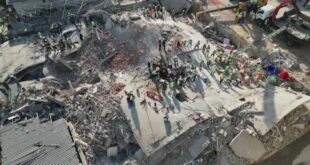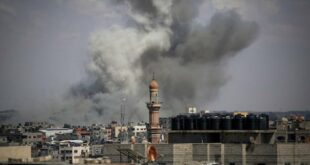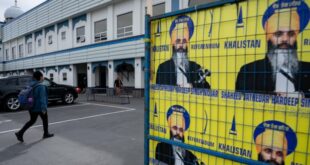Latest bombardment carried out by fighter jets and warships in Red Sea
The United States and Britain struck 36 Houthi targets in Yemen on Saturday in a second wave of assaults meant to further disable Iran-backed groups that have relentlessly attacked American and international interests in the wake of the Israel-Hamas war.
The latest strikes against the Houthis were launched by ships and fighter jets.
The strikes follow an air assault in Iraq and Syria on Friday that targeted other Iranian-backed militias and the Iranian Revolutionary Guard in retaliation for the drone strike that killed three U.S. troops in Jordan last weekend.
The Houthi targets were in 13 different locations and were struck by U.S. F/A-18 fighter jets from the USS Dwight D. Eisenhower aircraft carrier and by American warships firing Tomahawk missiles from the Red Sea, U.S. officials said. They were not authorized to publicly discuss the military operation and spoke on condition of anonymity.
The U.S. warned that its response after the soldiers' deaths at the Tower 22 base in Jordan last Sunday would not be limited to one night, one target or one group. But the Houthis have been conducting almost daily missile or drone attacks against commercial and military ships transiting the Red Sea and Gulf of Aden and they have made clear that they have no intention of scaling back their campaign. It was not immediately clear whether the allied assaults will deter them.

How the Houthis defied the U.S. | About That
18 days ago
As Houthi rebels in Yemen continue to disrupt global shipping traffic and attack ships in the Red Sea, the U.S. is hitting back. Andrew Chang outlines the risks of further escalation in the region, and how far both sides could be willing to go.
U.S. Defence Secretary Lloyd Austin said in a statement that the military action, with support from Australia, Bahrain, Canada, Denmark, the Netherlands, and New Zealand, "sends a clear message to the Houthis that they will continue to bear further consequences if they do not end their illegal attacks on international shipping and naval vessels."
He added: "We will not hesitate to defend lives and the free flow of commerce in one of the world's most critical waterways."
The Defence Department said the strikes targeted sites associated with the Houthis' deeply buried weapons storage facilities, missile systems and launchers, air defence systems and radars.
Saturday's strikes marked the third time the U.S. and Britain had conducted a large, joint operation to strike Houthi weapon launchers, radar sites and drones.
The strikes in Yemen are meant to underscore the broader message to Iran that Washington holds Tehran responsible for arming, funding and training the array of militias behind attacks across the Mideast against U.S. and international interests over the past several months, including in Iraq and Syria by the rebels in Yemen.
Video shared online by people in Sanaa, Yemen's Houthi-controlled capital, included the sound of explosions and at least one blast was seen lighting up the night sky. Residents described the blasts as happening around buildings associated with the Yemeni presidential compound. The Houthi-controlled state-run news agency, SABA, reported strikes in al-Bayda, Dhamar, Hajjah, Hodeida, Taiz and Sanaa provinces
On Friday the U.S. destroyer Laboon and F/A-18s from the Eisenhower shot down seven drones fired from Houthi-controlled areas of Yemen into the Red Sea, the destroyer Carney shot down a drone fired in the Gulf of Aden and U.S. forces took out four more drones that were prepared to launch.
Hours before the latest joint operation, the U.S. took another self-defence strike on a site in Yemen, destroying six anti-ship cruise missiles, as it has repeatedly when it has detected a missile or drone ready to launch.
'We do not wish to escalate'
The Houthis' attacks have led shipping companies to reroute their vessels from the Red sea, sending them around Africa through the Cape of Good Hope — a much longer, costlier and less efficient passage. The threats also have led the U.S. and its allies to set up a joint mission where warships from participating nations provide a protective umbrella of air defence for ships as they travel the critical waterway that runs from the Suez Canal down to the Bab el-Mandeb Strait.
During normal operations about 400 commercial vessels transit the southern Red Sea at any given time.
The U.S. has blamed the Jordan attack on the Islamic Resistance in Iraq, a coalition of Iranian-backed militias. Iran has tried to distance itself from the drone strike, saying the militias act independently of its direction.
.jpg?crop=1.777xh:h;*,*&downsize=510px:*510w)
U.S. retaliates against militias in Iraq and Syria
1 day ago
The United States launched airstrikes against Iran-backed militia facilities in Iraq and Syria in retaliation for drone strikes that killed three U.S. troops in Jordan a week earlier.
Hussein al-Mosawi, spokesperson for Harakat al-Nujaba, one of the main Iranian-backed militias in Iraq, condemned the earlier U.S. strike in Iraq and said Washington "must understand that every action elicits a reaction." But in the AP interview in Baghdad, he also struck a more conciliatory tone. "We do not wish to escalate or widen regional tensions," he said.
Mosawi said the targeted sites in Iraq were mainly "devoid of fighters and military personnel at the time of the attack."
Rami Abdurrahman, who heads the Britain-based Syrian Observatory for Human Rights, said that 23 people, all rank-and-file fighters, were killed. Iraqi government spokesperson Bassim al-Awadi said in a statement 16 people, including civilians, were killed and there was "significant damage" to homes and private properties.
The U.S. said it had informed Iraq about the operation before it started.
A U.S. official said an initial battle damage assessment showed the U.S.had struck each of its planned targets in addition to a few "dynamic targets" that popped up as the mission unfolded, including a surface-to-air missile site and drone launch sites. The official, who spoke on the condition of anonymity to provide details that were not yet public, did not have a casualty assessment.
The Iraqi government has been in a delicate position since a group of Iranian-backed Iraqi militias calling itself Islamic Resistance in Iraq began launching attacks on U.S. bases in Iraq and Syria on Oct. 18. The group described the strikes as retaliation for Washington's support for Israel in the war in Gaza.
Behind the scenes, Iraqi officials have attempted to rein in the militias, while also condemning U.S. retaliatory strikes as a violation of Iraqi sovereignty and calling for an exit of the 2,500 U.S. troops who are in the country as part of an international coalition to fight IS. Last month, Iraqi and U.S. military officials launched formal talks to wind down the coalition's presence, a process that will likely take years.
*****
Credit belongs to : www.cbc.ca
 MaharlikaNews | Canada Leading Online Filipino Newspaper Portal The No. 1 most engaged information website for Filipino – Canadian in Canada. MaharlikaNews.com received almost a quarter a million visitors in 2020.
MaharlikaNews | Canada Leading Online Filipino Newspaper Portal The No. 1 most engaged information website for Filipino – Canadian in Canada. MaharlikaNews.com received almost a quarter a million visitors in 2020.







